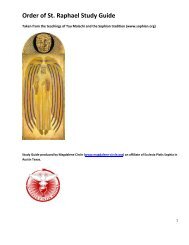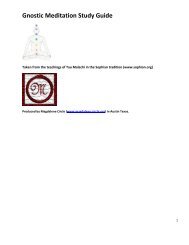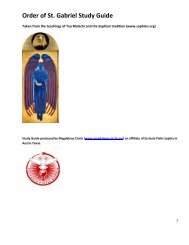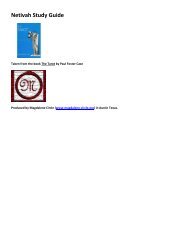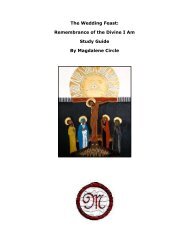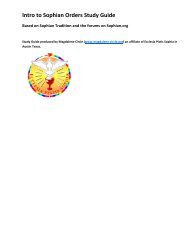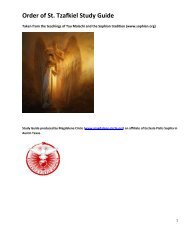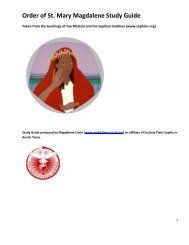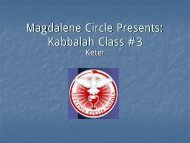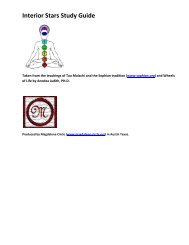Introduction to Sophian Gnosticism Study Guide - Magdalene Circle
Introduction to Sophian Gnosticism Study Guide - Magdalene Circle
Introduction to Sophian Gnosticism Study Guide - Magdalene Circle
- No tags were found...
Create successful ePaper yourself
Turn your PDF publications into a flip-book with our unique Google optimized e-Paper software.
Birth of a MysticIn <strong>Sophian</strong> teachings, Yeshua is conceived through the sexual union of Joseph & Maryand even though he is a great soul and spiritual prodigy, he is not born Christed. Thes<strong>to</strong>ry of immaculate conception is considered a myth that is meant <strong>to</strong> conveymysteries of the journey <strong>to</strong> Christ consciousness and the fact that Yeshua was bornfree of the karmic ties that most humans bare. Being born in a barn among animalsis quite symbolic also, as it conveys the idea of the bestial soul (Nefesh) beingtransformed through the process of enlightenment and the actualization of the soulof light (Neshamah).The view of Yeshua being conceived in a natural way is common <strong>to</strong> most Christian Gnostic traditions. Thissubject is also covered in several Gnostic Gospels. The term for Holy Spirit in Hebrew, Ruach Ha-Kodesh, like theterm for God’s divine presence and power, Shekinah, is feminine. There is birth and there is rebirth. Thespiritual birth is a sparking of fiery intelligence and a movement of Grace through Mother Sophia. She ispersonified in the Gospels as Mother Mary.Emergence of the Light-Presence and Light-BearerThe baptism and temptation are the fruition of a long spiritual journey begun in Yeshua’s youth. Thisculminated around the age of 30. This represents light-transmission between a Tzaddik and disciple when thedistinction between the two vanishes and there is only the one light-presence.Words like light-transmission, light-presence, and light-continuum can be somewhat curious and undoubtedlyvague. To someone who has experienced these, they are perfectly clear. The words point at it, but it is actuallya spiritual experience. If a person embodies something of this divine presence, it can be transmitted <strong>to</strong> others –a shared experience can be facilitated. The light-transmission between a Tzaddik and a disciple is somewhatakin <strong>to</strong> a candle that is lit, drawing near <strong>to</strong> another candle. When they separate, both are lit, illuminated andilluminating. It is like the Tzaddik is akin <strong>to</strong> a midwife, and the disciple is one who is in labor <strong>to</strong> give birth <strong>to</strong> theChrist self. It is ultimately the disciple who must work out his or her self-realization and pass through the painsof labor <strong>to</strong> enter in<strong>to</strong> the joy of having given birth.After his baptism, Yeshua was driven out in<strong>to</strong> the wilderness <strong>to</strong> be tempted by Satan. There are many esotericteachings on exactly who and what Satan is among the various traditions of Gnostic Christianity. The nameSatan literally means “adversary”. In Judaic tradition the name is Samael, which means the “poison of God”. Onthe most basic and universal level, Gnostic teachings consider Satan, the ego-illusion. This produces the illusionof separation of us from one another and God. This is called the “evil inclination” in Kabbalah. Because of egoillusionwe tend <strong>to</strong> identify ourselves only with the surface consciousness, our mortal name and form, andpersonal his<strong>to</strong>ry. Yet on a deeper level, there is a part of us that exists beyond space-time – the person of light.All of the temptations by Satan are a product of the ego-illusion. The banishing of Satan, thus, represents thedissolution of the ego-illusion and self-grasping.The Second AdamYeshua stands at the center of the Gospel as a holy person who realizes and embodies supernal consciousness.Yet, in the <strong>Sophian</strong> Gospel, he does not stand alone. Others around Yeshua embody the light-presence, more orless. This becomes most obvious in Gnostic Christian traditions, which speak of St. Mary <strong>Magdalene</strong> as co-equaland co-preacher of the Gospel with Yeshua, and which view Mary <strong>Magdalene</strong> as the divine consort and wife ofYeshua - the female embodiment of the Chris<strong>to</strong>s (Christ presence). In the canonized Scriptures there is a hint at



